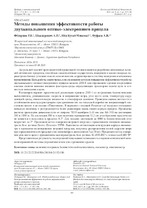| dc.contributor.author | Фёдорцев, Р. В. | ru |
| dc.contributor.author | Шкадаревич, А. П. | ru |
| dc.contributor.author | Кусай, Мохамад Ийд | ru |
| dc.contributor.author | Фуфаев, А. В. | ru |
| dc.coverage.spatial | Минск | ru |
| dc.date.accessioned | 2018-06-18T08:05:53Z | |
| dc.date.available | 2018-06-18T08:05:53Z | |
| dc.date.issued | 2018 | |
| dc.identifier.citation | Методы повышения эффективности работы двухканального оптико-электронного прицела = Methods for increasing the efficiency of a dual-channel opto-electronic sight / Р. В. Фёдорцев [и др.] // Приборы и методы измерений : научно-технический журнал. - 2018. – Т. 9, № 2. – С. 182-196. | ru |
| dc.identifier.uri | https://rep.bntu.by/handle/data/42039 | |
| dc.description.abstract | Актуальной задачей производителей прицельной техники является разработка автономных моделей оптических прицелов, способных самостоятельно осуществлять измерение и анализ входных параметров в боевых условиях и на их основе вносить корректировки в систему наведения и механизмы прицеливания. Цель работы заключалась в исследовании методов повышения эффективности работы двухканального оптико-электронного прицела модели DNS-1 для стрелкового оружия посредством анализа степени влияния внешних факторов среды определяющих траекторию полета пули и точность ее попадания в цель. Рассмотрен вариант практической реализации прицела DNS-1 со встроенным баллистическим вычислителем, учитывающим: скорость и направление ветра, угол места цели, температуру окружающей среды, относительную влажность и атмосферное давление. Проведена оценка жесткости и устойчивости конструкции прицела при креплении его на ствольной коробке по направляющей «ласточкин хвост» и на планке «Пикатинни». В варианте с планкой Picatinny rail нагрузки составляют меньшую величину и распределяются более равномерно вдоль линии корпуса прицела. Проведены расчеты траектории движения пули от патрона 7Н10 калибром 5,45 мм для АК-74Н на дистанциях 300 и 1000 м. На дистанции 300 м и при величине превышения 53,2 см угол бросания практически не меняется и находится в пределах 0,2°. Для дальних дистанций до 1000 м баллистический угол возрастает до 3°. Предложен метод измерения ветровой нагрузки с применением теплового анемометра на базе датчика Dantec Dynamics 55P11. Выполнена оптимизация конструкции корпуса анемометра и проведено моделирование ветровой нагрузки, получены распределения полей скорости ветра при аэродинамической продувке узла анемометра в диапазоне от 2 до 20 м/с. Предложен метод измерения угла места цели с применением акселерометра на базе датчика SCA830-D07 с точностью 0,00179°. Представленные результаты исследований показывают возможность создания комплексной автоматизированной системы управления огнем для стрелкового оружия. | ru |
| dc.language.iso | ru | ru |
| dc.publisher | БНТУ | ru |
| dc.title | Методы повышения эффективности работы двухканального оптико-электронного прицела | ru |
| dc.title.alternative | Methods for increasing the efficiency of a dual-channel opto-electronic sight | en |
| dc.type | Article | ru |
| dc.identifier.doi | 10.21122/2220-9506-2018-9-2-182-196 | |
| local.description.annotation | The actual task of the aiming equipment manufacturers is to develop autonomous models of optical sights capable of independently measuring and analyzing input parameters in combat conditions and on their basis to make corrections to the guidance system and aiming mechanisms. The aim of the study was to investigate methods for increasing the efficiency of the dual-channel opto-electronic sight of the DNS-1 model for small arms by analyzing the degree of influence of external environmental factors determining the trajectory of a bullet flight and the accuracy of its hit into the target. The variant of the practical implementation of the DNS-1 sight with an integrated ballistic computer, taking into account: wind speed and direction, target location angle, ambient temperature, relative humidity and atmospheric pressure is considered. Evaluation of the rigidity and stability of the sight design was made when fastening it to the receiver along the «swallowtail» guide and on the «Picatinny» bar. In the variant with Picatinny rail, the loads are smaller and distributed more evenly along the line of the body of the sight. Calculations of the trajectory of the bullet from the cartridge 7Н10 with a caliber of 5.45 mm for the AK-74Н at distances of 300 and 1000 m were carried out. At a distance of 300 m and at a value exceeding 53.2 cm, the throwing angle remains practically unchanged and lies within 0.2°. For long distances up to 1000 m, the ballistic angle increases to 3°. A method for measuring wind load using a thermal anemometer based on the Dantec Dynamics 55P11 sensor is proposed. Optimization of the anemometer housing design was performed and wind load simulation was performed, wind field velocity distribution was obtained in the aerodynamic blowdown of the anemometer assembly in the range from 2 to 20 m/s. A method is proposed for measuring the angle of the target site using an accelerometer based on the SCA830-D07 sensor with an accuracy of 0.00179°. The presented research results show the possibility of creating a complex automated fire control system for small arms. | en |

